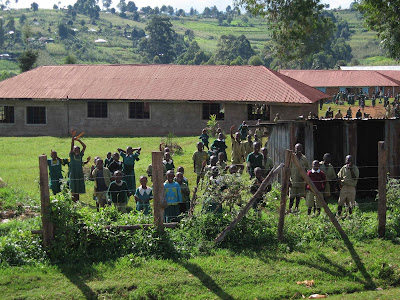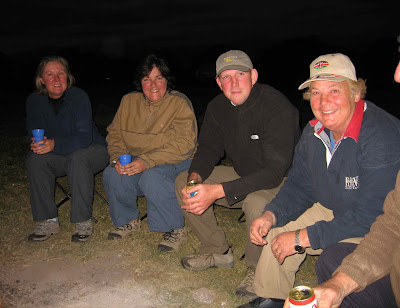I travelled with Exodus on their Kenya & Tanzania Adventure.
Day 1
Good flight on Kenyan Airways from Amsterdam, with reasonable food and attentive service. Easily through Nairobi airport and met others in the group and leader Paul, crewman Emias and cook extraordinaire Bhachi. A two and a half hour drive before a short rest break with views of the Rift Valley and Mount Logonot 2777m, albeit in overcast conditions.
 |
| Rift Valley and Mt Logonot, 2777m |
 |
| Superb starling |
 |
| Fish Eagle Camp, Lake Naivasha |
 |
| Marabou storks |
 |
| Elsamere |
Walking safari at the Crater Wildlife Sanctuary, about one hour’s boat ride from the camp. Hippos, locals washing in the lake, and splendid views of the surrounding hillsides. Many birds spotted: Malachite, pied and great kingfisher, Egyptian geese, black tailed and white breasted cormorants, fish eagles, Goliath heron, Squaco heron, white backed pelican and Sacred Ibis.
Our walk took us 2-3 hours, with help from a Masaai game warden who encouraged some giraffe towards us for better viewing. Up close to zebra, impala, Thompson’s Gazelle and Eland, with a brief glimpse of the shy dik-dik. More birds: auger buzzards and lilac breasted rollers, plus blacksmith plovers and black-headed heron at the lakeside.
Reflecting past volcanic activity in the area, the shores of the lake were covered in small fragments of black volcanic glass, obsidian.
 |
| Lake Naivasha |
 |
| Walking safari at the Crater Wildlife Sanctuary |
 |
| Giraffe, Crater Wildlife Sanctuary |
A truck drive of almost three hours to the fourth largest town in Kenya, Nakuru, on pot-holed tarmac. Had fun with the friendly locals who were keen to sell you all sorts of tat, before moving on to the Kembu campsite, arriving just before dark. English owned and dealing with locals who thieve their water supplies, this was a pleasant spot for food and a few beers. The campsite is at 2400m.
 |
| Street traders, Nakuru |
An early start for a game drive in Lake Nakuru National Park. Early sightings of baboon, buffalo, zebra and white pelican, but the star attraction here is the many thousands of lesser flamingos (plus a smaller number of the white greater flamingo) who flock to feed on the peculiar soup that calls itself a ‘soda lake’. A magnificent sight, with the lake pink-fringed by thousands of the lesser flamingo, although I’ll never forget the smell of the inevitable ‘guano’.
Other sightings: Impala, water buck, crowned crane (the national bird of Kenya), eland, ostrich, jackal and warthogs. A white rhino with cub, yellow billed storks, ground hornbill (strangely, nesting in a hole in a tree trunk well off the ground) and…then…a magnificent sighting of a leopard in an acacia tree with a dead impala in its mouth (a great spot by Marg Loader of Kangaroo Island, South Australia, who was travelling with us).
 |
| Baboon, Lake Nakuru National Park |
 |
| Flamingo on Lake Nakuru |
 |
| Buffalo, Lake Nakuru National Park |
 |
| Flamingo on Lake Nakuru |
 |
| Leopard with impala kill, Lake Nakuru |
 |
| Agama lizard |
 |
| On Baboon Rock, overlook to Lake Nakuru |
Day 5
A two hour drive to Kisii for a quick fuel stop, before venturing on towards Tanzania. As we descended towards the border we left the tea plantations and passed banana trees, maize and eventually sugar beet and papaya, very similar to the countryside in the Caribbean. A good road surface as far as Kisii, but rougher as we got nearer to the border.
Before we had set off for the day, a number of traders had arrived at the campsite offering soapstone (steatite) carvings. We were now passing the soapstone quarries as we travelled south from Kisii, the main source in the world for this very workable rock.
The people seemed friendlier as we travelled on, many shouting a greeting and waving as we passed. Indeed a whole school turned out to wave as we waited for the road to clear ahead at one point. We passed through many scruffy market towns, but what was really noticeable was the ubiquitous mobile phone…many adults seemed to have one and the level of poster marketing was amazing!
 |
| On the road to Kisii |
 |
| Tea plantations en route to Tanzania |
 |
| Kenyan school |
 |
| Koppie, Tanzania |
 |
| Village, northern Tanzania |
 |
| Local construction using bamboo scaffolding |
 |
| Sunset over Lake Victoria |
 |
| Tempo Beach Camp, Lake Victoria |
Day 6
 |
| Market stall in Musoma |
Then a two hour drive to the Ndabaka Gate to access the western corridor of the Serengeti. A quick lunch here, enlivened by a small snake in the Gents and visiting vervet monkeys who were attracted by our grub.
 |
| Looking back at our route across the Serengeti |
We saw the ‘migration’ first hand with blue wildebeest, zebra, Thompson’s gazelle and impala in their thousands, albeit moving at a slow pace (no river-crossings facing hungry crocs this time!). Occasional sightings of warthog, hartebeest and jackal, with a finale as we approached Seronera, seeing mating lions at close quarters. We had a remote camp at the Ngiri site, just north of Seronera, with very basic facilities.
 |
| Lions mating, Seronera, Serengeti National Park |
A restless night, with the usual hyena sniffing around the camp, some birds getting territorial at about 0130, flapping flysheets and finally lions roaring at 0440! So, easy to get up for an early game drive in the central Serengeti. More birds spotted, this time adding Marshall Eagle, crowned and wattled plovers, vultures, grey heron and kori bustards to our list. Hippos, a small crocodile and more mating lions, followed by topi, elephant, hartebeest and giraffe. The landscape comprises vast plains, with the occasional kopi, classic stands of acacia and large burnt areas, where man is managing the grassland. Spotted a Silverbird, plus ground squirrel and rock hyrax at the Serengeti Visitor Centre.
 |
| Sunrise over the Serengeti |
 |
| Crowned crane |
 |
| Hippo pool near Seronera |
In the afternoon we crossed the border of the Serengeti and the Ngorongoro Conservation Area (hereafter, the NCO), basically a clump of acacia in the middle of the seemingly endless plains. More giraffe and elephant with the usual herds of grazers, but increasingly we saw cattle, tended by Masaai with spears and dressed in their familiar red blanket, and villages and cattle pens dotted on the landscape. Passing Mount Oldeani 3216m on our right and Oldavai Gorge on our left, we climbed up to a subsidiary crater below the Ngorongoro rim, quite heavily populated by Masaai who were herding sheep and goats at this elevation.
Eventually reaching the crater rim we had our first amazing views of the Ngorongoro Crater, the floor of which was 610m below us and spanning a diameter of about 7 miles. It was a bit cloudy for decent photographs and we were approached by a number of enterprising Masaai who were selling themselves for photographs. Can’t blame them I suppose…
 |
| Lake Magadi, Ngorongoro Crater |
 |
| Simba Camp, above the Ngorongoro Crater |
 |
| Exodus group at Simba Camp |
Day 8
An early start in 4WD down into the crater, taking about 30 minutes to drive down the descent road. Elephant, hippo and a pride of lionesses feeding on a buffalo kill within the first hour, the latter ruined by the concentration of vehicles (18, I think!), which eventually spooked the animals. Black rhino, Thompson and Grants gazelle, blue wildebeest, zebra and buffalo. Good birding again, with crowned crane, lesser flamingo on Lake Magadi, great white pelican, black-capped avocet (the RSPB symbol), white heron, blacksmith plover, auger buzzard, ostrich and bright yellow lesser weaver birds to name but a few.
 |
| Early morning in the Ngorongoro Crater |
 |
| Lesser flamingo on Lake Magadi |
 |
| Lone elephant, Ngorongoro Crater |
 |
| Harassed lions trying to feed on a kill |
 |
| Looking back to Ngorongoro |
Left the Ngorongoro Conservation Area and had a quick lunch at Katuma before heading east on good roads for 3 hours, passing many Masaai communities on the way. Overnight stop at the Snake Park, about 30kms west of Arusha. Quite a noisy camp, busy with overlanders and quite close to a busy road.
Day 9
Visit to Masaai Museum and walked to a nearby village with Masaai guide. Well done overall, and gave a fairly good rendition of Masaai life.
 |
| Masaai village |
 |
| Masaai warriors |
 |
| Ozzie tourist with inquisitive village kids! |




No comments:
Post a Comment